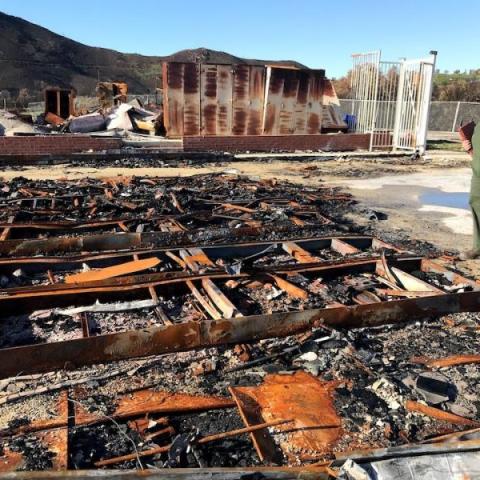
This female coyote turned up dead in December, apparently of drowning/NPS
Radio collars on wildlife can provide invaluable data to researchers pertaining to the animal's movements, behavior, and, in some cases, response to climate change. So when a collar falls off, goes silent, or the animal dies, a lot of potential research is scuttled. That's the case in Los Angeles, where a female coyote that was being tracked by National Park Service researchers appears to have drowned.
The coyote was found dead in a City of Los Angeles park in December. The female subadult coyote, known as C-146, was tracked for two months as part of researchers’ efforts to better understand how coyotes live in extremely urbanized areas.
“It’s really disappointing to lose her,” said Justin Brown, a National Park Service biologist who has been tracking her since she was captured on September 23. “The data we were collecting from her movements were very interesting.”
In the short time Brown tracked the coyote, her travels displayed unusual behavior for a species that is territorial. Since captured near the L.A. River in northeast L.A., she traveled as far south as downtown Los Angeles via the L.A. River, throughout Elysian Park, and into the Westlake neighborhood where she met her fate in MacArthur Park, a Park Service release said.
C-146 was found on December 4 near the park’s lake, which prompted the City of Los Angeles Department of Recreation and Parks to notify the National Park Service. Her body, which was found covered in algae and soaking wet, was sent to the California Animal Health & Food Safety Lab in San Bernardino for a necropsy.
Lab results identified the cause of death to be drowning.
“In the location she was found dead, it would have been extremely difficult for her to climb out due to the steep cement walls along the lake,” said Brown. “But I’m unsure why C-146 went into the lake. She may have jumped in to pursue a duck or waterfowl. She also may have fallen in while trying to get a drink, as animals commonly become very thirsty when exposed to anticoagulants, high levels of which were found in her body.”
Lab results detected first- and second-generation anticoagulant rodenticides in her liver, the Park Service reported. Anticoagulant rodenticides, which are used in rat poison, can work their way up the food chain. While first-generation anticoagulant rodenticides are widely available for purchase, second-generation anticoagulant rodenticides were banned by recent California legislation, although they can still be purchased by licensed applicators.
The anticoagulant rodenticides found in C-146 were brodifacoum, bromadiolone, difethialone, and diphacinone.
The National Park Service has been studying Los Angeles' most urban coyotes since May 2015. While coyotes have been widely studied, very little research exists on coyotes in the most extreme urban landscapes such as Los Angeles. Two other coyotes, C-144 and C-145, have also been studied in the area. Collars on both of those coyotes unfortunately died prematurely. The death of C-146 leaves the study on hold until new coyotes in the Los Angeles basin are captured and outfitted with GPS collars.
Since 1996, the National Park Service has been studying carnivores in and around Santa Monica Mountains National Recreation Area to determine how they survive in an increasingly fragmented and urbanized environment. During the course of the study, biologists have radio-tracked more than 300 bobcats, 140 coyotes, and 47 mountain lions.


 Support Essential Coverage of Essential Places
Support Essential Coverage of Essential Places







Add comment